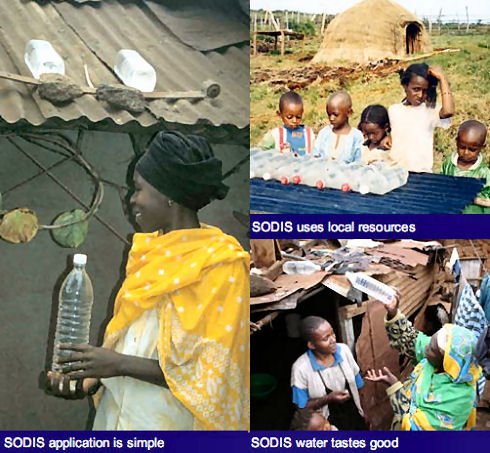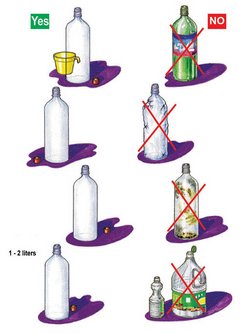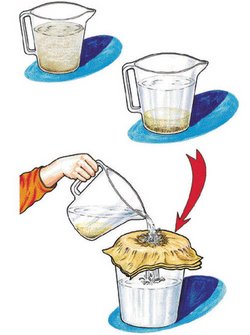Solar water disinfection (SODIS) has been around for quite some time now and with approx. over 340.000 users in Africa alone, this low budget water disinfection “technology” is a smart approach that deserves to be mentioned on AfriGadget.
In areas where piped drinking water just isn’t available or of questionable quality, solar water disinfection is a cheap and effective method for decentralized water treatment as it can be applied at household level. It is a simple method that’s easy to teach and is designed for small scale production.

(source )
SODIS uses solar radiation to destroy pathogenic microorganisms which cause water borne diseases:
Sunlight is treating the contaminated water through two synergetic mechanisms: Radiation in the spectrum of UV-A (wavelength 320-400nm) and increased water temperature. If the water temperature raises above 50°C, the disinfection process is three times faster. (source)
The World Health Organization (WHO) even recommends SODIS as a viable method for household water treatment and safe storage.
All you will need are clean & transparent PET bottles, fill them up with water and expose them to direct sunlight for at least 6 hours . Many people also put them on a corrugated roof (to increase temperature) and saturate the oxygen content inside the bottles prior to the sun treatment by filling them up three quarters, shaking them for 20 seconds with a closed cap on and then fill them up completely.


(source)
SODIS may also replace the boiling of water which often requires vast amounts of firewood or other natural resources, so it not only helps people obtain safer drinking water (conventional filter candles are expensive and not always available) but also helps to preserve the local environment.
SODIS obviously can’t substitute really clean drinking water, and it often also requires pre-treatment in case the water turbidity is too high . Users can easily reduce the turbidity though by letting the bottles stand for a while until the particles settle to the ground and then also filter it through a folded cloth.
The best aspect about SODIS though – despite of it’s low budget approach – is that consumers are directly in charge of their drinking water and have a working method that enables them to treat their own drinking water.
The Swiss Federal Institute of Aquatic Science and Technology (Eawag) also published a very informative website on SODIS and provides more details about the technology as well as case studies from around the world.


I’ve just come from L. Elementaita area where water has such high levels of flourine that it should not be drunk. Does Sodis offer any solutions for this that I can share with the communities out there??
I think this is brilliant – as we all know there are other solutions that depend on plastic vests and engineered containers that need to be produced elsewhere. Here we have a solution that depends on a “free local resource” (so long as the price of empty bottles doesn’t rise as demand grows) and is just as safe as the other methods, with appropriate training, which they all need.
Hi JKE good post. I wonder if it would be better to encourage use of glass bottles instead of PET bottles – Is there a danger of dioxin poisoning from the PET bottles exposure to high temps on the roof?
@Paula: I’ve asked Kilonzo and he wrote in the following:
@AfroM: Yes/No. Glass has some limitations concerning the depth of UV-A rays and afaik, there are hardly any relatively thin glass containers with twisted tops available in EAK as most of them are sold with crown caps, right?
As for the PET discussion, pls check out this FAQ which also concludes that “The health risk from SODIS water produced in PET bottles is not different from the health risk of other bottled water”. I think that makes sense, but again, I also feel a bit uncomfy as not all bottled water is sold in PET containers.
Please use 7 layers of clean cloth for filtering water. It almost completely traps turbidity causing material and also other organisms